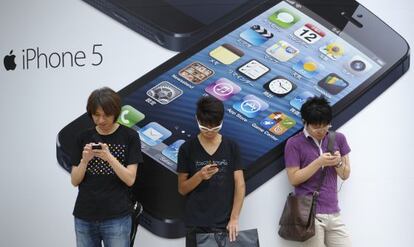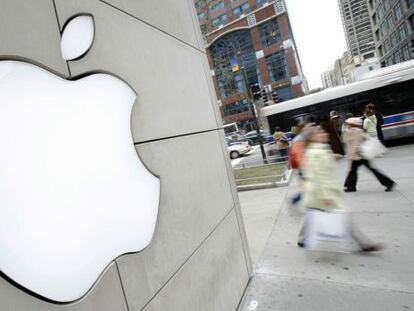Google can’t beat the App Store
Android cellphones may outnumber iPhones, but Apple’s clients spend more

The tickets, priced at $1,599 (roughly 1,200 euros), were sold out in minutes. Over 300,000 people wanted one. And it wasn’t for the Super Bowl, either, but for a meeting of Apple application developers.
Before the advent of the iPhone, Apple had to resort to personal calls to encourage people to attend the gathering. But everything changed with the launch of the cellphone. In 2008, the event was sold out for the first time, in a matter of weeks. For the 2012 conference, tickets lasted a few hours; this year, they were gone in two minutes. Expectation over the Apple Worldwide Developers Conference, which takes place from June 10 through 14 in San Francisco, is justified when one takes a look at the figures: the App Store catalogue lists more than 850,000 apps, of which 350,000 are for iPad tablets.
Since its creation in 2008, hand in hand with the iPhone, the App Store has had 45 billion downloads, and the pace in the last quarter is simply breathtaking: 800 downloads a second, nearly 70 million a day. There are three times as many Android-powered cellphones in the world as there are iPhones, yet the App Store continues to run rings around its competitor, Google Play.
Peter Oppenheimer, Apple’s CFO, underscores the value of applications that are free or less than a dollar, which is generally the case. Apple has paid out seven billion euros to its developer community, which includes third-party developers. Under the system, 70 percent of revenues generated by the program goes to the app publisher, and Apple keeps the remaining 30 percent. It is the kind of business that does not require store clerks, device repairmen or assembly chains. They are all digital goods that get distributed over the internet.
They make sure everything works. They give users a quality guarantee”
The fact that App Store operates in 155 countries has allowed developers to find a client base that would be hard to reach any other way. A Spanish mobile marketing company called Mubiquo, for instance, has created a worldwide app for the oil giant Shell, with versions in Chinese, Russian, Arabic and Turkish. It started out as a small studio and now has a staff of 40 spread out in offices in San Francisco, Madrid, Barcelona, Murcia and Shanghai.
Rubén Aparicio, its founder and CEO, believes there are no magic formulas, but he mentions a few keys to an app’s success: “Give some added value, something that goes beyond what you might get just surfing the web, with a good balance between usefulness and entertainment.” Mubiquo works chiefly for other companies that commission specific programs. It is behind cooking apps such as Nestlé Cocina and Nestlé Postres, whose approval took some time.
“Apple wanted to make sure it wasn’t publicity. They were really on top of the texts. It’s branded content. Many of the recipes don’t include brand products, in fact some of them are by [renowned Basque chef] Arzak.” The unwritten rule for any self-respecting developer is to first launch an app on iOS, the operating system for iPhone and iPad, and later on other platforms. Although it was created later, Android represents the greatest threat to Apple’s hegemony, not just through the official Google Play store, but also through the increasingly popular platform created by Amazon.
Vanatur, a mobile application company that focuses on the music and fashion industries, has just created an app based on the popular teen band Auryn. Their intention was to launch the app on both iOS and Android simultaneously, but in the end they only did it on Google cellphones.
“It’s more comfortable to develop for Apple, but the deadlines don’t depend on you,” says company director Estrella Caso, citing some factors to take into account when developing an application. “The first thing is to carefully select the target audience; after that, make sure it stays alive through updates and dynamism.”
Ana Ormaechea, founder of Tablet Army, feels that the approval process at the Apple Store is not entirely adequate. “There is a cultural barrier, and you can feel it,” she says. “Everything goes through Cupertino (Apple’s headquarters in California), and they lack the necessary context to realize that what may not be considered correct there, is considered correct here.”
Why can't Google help users to find the desired program in a matter of seconds?
But the independent developer Diego Bezares, creator of Rhythmic Thumbs, values that kind of control: “They make sure everything works. They give users a guarantee that they will not be downloading disappointing products.” Bezares also underscores the importance of needing a credit card to register on the App Store. “Android sales are slowly growing, but not at the levels seen in Apple, where customers only have to click and their purchase is complete.”
AppGratis is one of the applications that was recently axed by Apple’s relentless control system. It had been working without glitches for two years, and it was one of the most popular downloads on the Apple platform. But two weeks ago, it vanished from the App Store. The application consisted of affording free access, for just one day, to apps for which you usually have to pay. But Apple has no tolerance for those who would set up a parallel business within its own shop windows. And yet AppGratis made up for one of the store’s problems, which is finding something interesting in a short amount of time.
Aparicio believes that Apple is aware of the problem: “A couple of months ago, I had a meeting with the vice-president of the App Store. I told him that since the October changes went into effect, it is hard to find the charts with the top-selling apps in each category. Since then, there are fewer downloads and it goes slower.”
Bezares has the same feeling. “Visibility is reduced to the first 50 applications,” he notes.
Google Play has more problems, and it’s not just that a greater volume of Android mobiles is not resulting in more app sales. Aparicio is at a loss to explain why Google, a major search engine, seems unable to develop a way for users to find the desired program in a matter of seconds. “It’s pathetic,” he says. “Even if you type in the exact name, it does not turn up in the results.” Meanwhile, Caso attacks one of the green robot’s weak spots: fragmentation, the term used for the diversity of characteristics in cellphones and tablets.
“The programs don’t get checked, and each particular screen size or processing power is a world unto itself. It is very hard not to let down people with older cellphones.”
Apple keeps a firm control over its store. Even though 64 percent of the world’s mobile phones run on Android and only 19 percent are iPhones, the App Store continues to lead the way. And while it is true that this year, downloads on Google Play will surpass those on App Store, the same cannot be said for sales. The owner of an iPhone is technologically more sophisticated, and tends to download more apps, and not just free ones, either. He or she uses credit cards more often. According to the App Annie Index, App Store revenues in the last quarter were 2.6 times greater than Google Play revenues, and during the Christmas season the proportion was four to one. The App Store continues to hold its own against the Android onslaught. For now.
Tu suscripción se está usando en otro dispositivo
¿Quieres añadir otro usuario a tu suscripción?
Si continúas leyendo en este dispositivo, no se podrá leer en el otro.
FlechaTu suscripción se está usando en otro dispositivo y solo puedes acceder a EL PAÍS desde un dispositivo a la vez.
Si quieres compartir tu cuenta, cambia tu suscripción a la modalidad Premium, así podrás añadir otro usuario. Cada uno accederá con su propia cuenta de email, lo que os permitirá personalizar vuestra experiencia en EL PAÍS.
¿Tienes una suscripción de empresa? Accede aquí para contratar más cuentas.
En el caso de no saber quién está usando tu cuenta, te recomendamos cambiar tu contraseña aquí.
Si decides continuar compartiendo tu cuenta, este mensaje se mostrará en tu dispositivo y en el de la otra persona que está usando tu cuenta de forma indefinida, afectando a tu experiencia de lectura. Puedes consultar aquí los términos y condiciones de la suscripción digital.
More information
Últimas noticias
Most viewed
- Why we lost the habit of sleeping in two segments and how that changed our sense of time
- Charles Dubouloz, mountaineering star, retires at 36 with a farewell tour inspired by Walter Bonatti
- Venezuela faces its most tense Christmas yet
- CBS in crisis after pulling a report on Trump’s deportations to El Salvador (which later leaked online)
- Bukele clan fumes over investigation exposing their new wealth









































